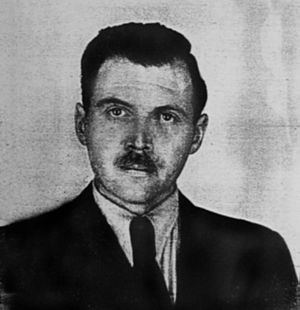Josef Mengele facts for kids
Quick facts for kids
Josef Mengele
|
|
|---|---|
 |
|
| Nickname(s) | Angel of Death (German: Todesengel) |
| Born | March 16, 1911 Günzburg, Kingdom of Bavaria |
| Died | February 7, 1979 (aged 67) Bertioga, São Paulo, Brazil |
| Allegiance | |
| Service/ |
|
| Years of service | 1938—1945 |
| Rank | Hauptsturmführer, SS (Captain) |
| Commands held | Human medical experimentation performed on prisoners at Auschwitz concentration camp, and selection of prisoners to be gassed at Auschwitz |
| Battles/wars | World War II |
| Awards | Iron Cross First Class Black Badge for the Wounded Medal for the Care of the German People |
| Spouse(s) | Irene Schönbein |
| Children | Rolf Mengele |
| Signature | |
Josef Mengele (born March 16, 1911 – died February 7, 1979) was a German officer and doctor. He worked for the Schutzstaffel (SS) during World War II. He was stationed at the Auschwitz concentration camp.
While at Auschwitz, Mengele performed very harmful experiments on prisoners. He was also part of a group of doctors who decided which prisoners would be sent to their deaths. Prisoners who were thought to be able to work were allowed into the camp. Those who were not fit for labor were immediately sent to the gas chambers.
As Soviet forces approached Poland, Mengele left Auschwitz on January 17, 1945. This was just 10 days before the Soviets arrived. After the war, he escaped to South America. He managed to avoid being caught for the rest of his life.
Mengele earned degrees in anthropology and medicine. He joined the Nazi Party in 1937 and the SS in 1938. He started World War II as a medical officer. In early 1943, he was sent to work in Nazi concentration camps, including Auschwitz. There, he saw a chance to do research on human genetics. His experiments mostly focused on twins. However, he did not care about the health or safety of the people he experimented on.
Mengele sailed to Argentina in July 1949. He was helped by former SS members. He first lived near Buenos Aires. Later, he fled to Paraguay in 1959 and Brazil in 1960. He was wanted by West Germany, Israel, and people who hunted former Nazis, like Simon Wiesenthal. They wanted him to face trial for his actions. He avoided capture, even with governments asking for him and secret missions trying to find him.
Who Was Josef Mengele?
Josef Mengele was born on March 16, 1911, in Günzburg, Bavaria, Germany. He was the oldest of three children. His parents were Karl and Walburga Mengele. His father started a company that made farm machinery. Mengele did well in school and enjoyed music, art, and skiing. After high school in 1930, he studied medicine and philosophy.
Munich was the main city for the Nazi Party. In 1931, Mengele joined a group called Stahlhelm, Bund der Frontsoldaten. This group later became part of the Nazi Sturmabteilung (SA).
In 1935, Mengele earned a PhD in anthropology. In 1937, he became an assistant to Dr. Otmar Freiherr von Verschuer. Dr. von Verschuer was a scientist who studied genetics, especially in twins. Mengele's work focused on genetic factors that caused things like a cleft lip and palate.
On July 28, 1939, Mengele married Irene Schönbein. They had one son, Rolf, who was born in 1944.
After the War: Escape and Hiding
Mengele bought a house in Caieiras, Brazil, in 1969. His son, Rolf, visited him there in 1977. Rolf had not seen his father since 1956. During the visit, Rolf found that his father still believed in Nazi ideas. Mengele claimed he had never personally harmed anyone and had only done his job.
Mengele's health was getting worse since 1972. He had a serious health problem in 1976. He also had high blood pressure and an ear infection that affected his balance. On February 7, 1979, he was visiting friends in Bertioga, a coastal town. He had another health problem while swimming and died by drowning. Mengele was buried in Embu das Artes. He was buried using the name "Wolfgang Gerhard," which was an identification card he had been using since 1971.
Images for kids
-
(from l. to r.) Richard Baer, Josef Mengele, and Rudolf Höss in Auschwitz, 1944 (Höcker Album)
See also
 In Spanish: Josef Mengele para niños
In Spanish: Josef Mengele para niños








